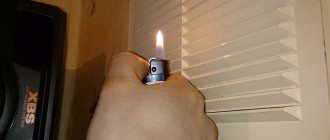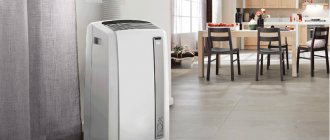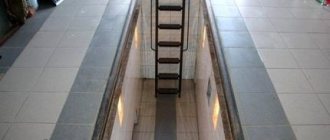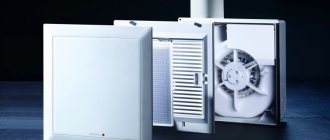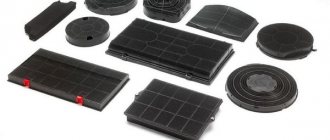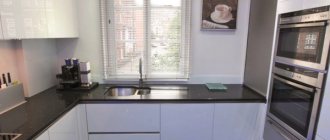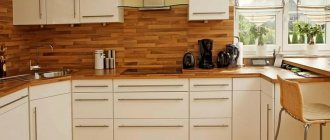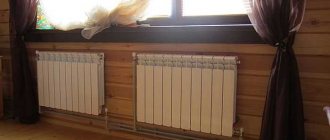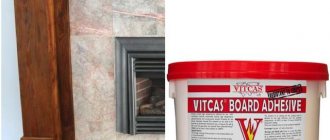Kitchen hood with duct
This device comes in two types depending on the principle of operation. In the first case, the air undergoes special cleaning and then enters the room again; in the second, the air is not cleaned, but is simply removed through ventilation.
The hood helps eliminate unpleasant odors, grease and soot. Therefore, it is especially important to install it correctly . It is better to decide in advance on the placement of the outlet, since these devices are produced with short cords. A flat hood can hang directly on the wall or be mounted in kitchen furniture. It has two holes. The one that will not connect to the air path is covered with a special lid. If the hood is built into a cabinet, you will have to make an additional hole for the air duct to exit.
If we are talking about a private house, then the issue is resolved more simply. Initially, you need to think about the layout of the kitchen and place the ventilation hole as close as possible to the stove. This is more difficult to do in an ordinary city apartment.
You have to choose possible ways to install an air duct for a kitchen hood.
You should immediately exclude the option when the stove is located on the opposite side with respect to the outlet of the ventilation system. In this case, the length of the air duct will most likely be more than three meters and will have many bends. This, in turn, will significantly reduce the efficiency of the entire kitchen ventilation system and increase background noise.
Installation
It is quite possible to install the air duct yourself. Corrugated options are considered the simplest in these matters. You just need to cut it into pieces of the required sizes, and then connect it with the corresponding parts of the hood and shaft in the kitchen. It is better to replace a simple ventilation grille with a special one - which has a built-in connecting pipe. For fastening in this case, special crimp clamps are usually used. For maximum reliability, the joints are treated with a sealing compound.
Air ducts made from PVC raw materials are installed in the same way. The pipe is cut using a hacksaw into separate pieces of the required size, after which it is attached to the hood parts using adapters. The pipe should go 50 mm (approximately) into the pipe. The fastening areas must be coated with silicone compound.
If you have installed a high-power hood in the kitchen, the reverse draft effect may make itself felt. Simply put, there will be odors in the room coming from the ventilation shaft. This applies to particularly powerful units, the performance level of which ranges from 600 to 700 cubic meters of air per hour. To avoid this problem, it is worth fixing the check valve.
These devices are available in two main variations:
- filmy appearance;
- in the form of a plastic disk on an axis.
How to hide equipment?
Plastic parts fit into various interiors much more easily, especially when compared with metal ones. However, they can also ruin the appearance of the kitchen ensemble. That is why most owners prefer to simply close such elements. There are different ways to do this correctly.
Let's look at the most common of them.
- It is permissible to hide the air duct pipes under a suspended or multi-level ceiling. For this purpose, you need to assemble a box from sheets of plasterboard - it will perfectly hide the entire system. However, this method can be used only if a major renovation is planned in the kitchen with a complete replacement of the ceiling base. If the hood is installed after finishing work is completed, then it will hardly be possible to hide it under these structures.
- To disguise the air duct, they often buy a special box made of polyvinyl chloride (sometimes other materials are used). Such designs will play a decorative role, so they are usually selected to match the decoration of the room. You can also add spotlights into these boxes.
- The hood can be hidden in the furniture in the kitchen if it is made to order. To do this, you need to notify the master of your preferences.
Useful tips
When selecting an air duct, one rule should be taken into account: the diameter of the exhaust pipe must correspond to the diameter of the hole that leads to the shaft. When choosing flexible options, you need to consider that you can do no more than 3 bends and bends.
It is recommended to install the hood in accordance with the direction of air movement. Otherwise, the service life of the device may be shortened, especially if it is a plastic part. The hood can also be taken outside. For this purpose, a hole of a suitable size must be made in the wall of the house. However, do not forget that before carrying out these operations you need to obtain permission from the BTI and housing and communal services.
The worst option is a corrugated plastic pipe that serves as an air outlet. It is better to give preference to an aluminum specimen. It is not recommended to place metal corrugations in the same ensemble with a kitchen set made of natural wood. Such an interior will look disharmonious and even ridiculous.
It is recommended to stretch corrugated pipes to their full length during installation. In this way, it will be possible to avoid contamination in the internal part, which will cause unnecessary noise during the operation of the system. Today, many users prefer built-in hoods. In these models, the air duct must be placed in the inside of the cabinet or fixed on its upper part.
In the next video you will see the installation of an air duct for a kitchen hood.
Related Posts
- Plastic ventilation pipes for hoods: types, their characteristics, application
- Correct installation of a hood in the kitchen with your own hands
- Carbon filter for hood: device, principle of operation and replacement technology
- Corrugated air ducts for ventilation: corrugated hoses and corrugated pipes
- How to install a hood in the kitchen with your own hands
- How to make and close a hood box in the kitchen
- Choosing a corner hood for the kitchen
- Dimensions and types of plastic air ducts for ventilation
- How to clean the ventilation in an apartment yourself
- Replacing backlight lamps in hoods
- Ventilation grille with non-return valve
- How to calculate the cross-section and diameter of an air duct?
- How to choose a hood over a gas stove: what criteria to consider when choosing a suitable model
- Kitchen hoods without an air duct: types, reviews, photos
- How to choose a hood for the kitchen: advice from professionals or independent choice?
- Ventilation in a suspended ceiling
- Rules for the location and installation of sockets on the kitchen apron
- How to calculate the power of a kitchen hood
- How to attach air ducts to the wall yourself
- Kitchen 5 sq. m: 20 photo examples + ideas
- Kitchen design 8 sq. meters. photo selection of the best projects (70 photos)
- Corrugated hood: how to choose and install a corrugated pipe for ventilation
- 10 tips for those planning a kitchen renovation
- How to update old tiles in the bathroom
- How to glue fiberglass correctly?
Read with this
- Plastic ventilation pipes for hoods: types, their characteristics, application
- Correct installation of a hood in the kitchen with your own hands
- Carbon filter for hood: device, principle of operation and replacement technology
- Corrugated air ducts for ventilation: corrugated hoses and corrugated pipes
- How to install a hood in the kitchen with your own hands
- How to make and close a hood box in the kitchen
- Choosing a corner hood for the kitchen
- Dimensions and types of plastic air ducts for ventilation
- How to clean the ventilation in an apartment yourself
- Replacing backlight lamps in hoods
Characteristics of plastic air ducts
Plastic pipes can be round or rectangular in cross-section. Rectangular air ducts fit better into the kitchen interior. It should be noted that the best, in terms of efficiency, are round pipes , since they have lower air resistance. But in any case, it is better to immediately purchase various types of adapters along with the pipes. Pay special attention to the adapter from the hood outlet to the air duct and from the air duct to the ventilation hole. For a tighter seal, it is better to use regular sealant. Plastic pipes can be cut using a regular hacksaw and connected without much difficulty.
The advantages of plastic pipes are as follows:
- noise from ventilation operation is significantly reduced;
- grease, soot and dirt do not accumulate in such an air duct, since the surface is smooth;
- last longer than 10 years and do not require additional maintenance. Such pipes are very light, so they do not create additional load on the entire structure of the exhaust system.
Rules for laying the air duct from the hood to the ventilation shaft opening
The quality of the hood’s operation directly depends on how correctly the air duct is laid to the ventilation hole.
When planning your route, remember:
- The bending angle should only be obtuse (more than 90º). A right angle bend will take about 10% of the hood's performance. If the duct has bends less than 90º, this can create backdraft.
- The more bends, the more performance drops. If you get a lot of bends (3 or more), you should make them as smooth as possible.
- The length of the air duct should ideally not exceed 3 meters. Each meter will take 5-10% of the hood’s performance.
Installing an exhaust duct (video)
Characteristics of corrugated pipes
Such pipes are made of thin aluminum. In this case, there is a significant disadvantage - the appearance of the air tract . It is unlikely that there will be many who want to see a metal pipe in their kitchen. Therefore, the use of this material requires obligatory masking of the pipe. But there are also obvious advantages:
- ease of installation work - corrugated pipe is easy to cut, can be bent at any angle, and is easily attached using special clamps;
- lack of resonant hum;
- low cost compared to plastic air ducts;
- Sharp pipe bends are eliminated, which increases the efficiency of the ventilation system.
Such pipes are produced in the form of small pieces that stretch to a significant length.
Determining the diameter and design of the duct
It is very important to correctly determine the diameter and design of the pipes. To do this, it is important to follow the following rules:
- It is desirable that the diameter of the air duct be equal to or greater than the diameter of the outlet from the kitchen hood and be equal to the diameter of the outlet ventilation hole. If the pipe has a smaller cross-sectional size, this will worsen the performance of ventilation , since additional resistance to moving air will be created. At the same time, the background noise will increase, and the hood motor will have to work in increased mode. All this will lead to rapid equipment failure. There is no point in making an air duct of a larger diameter if the tract narrows in the area of the ventilation hole. Therefore, it is most effective to accurately measure all the elements even before purchasing a kitchen hood;
- There should be a minimum of bends throughout the entire duct. If they are present, it is important that the angle is not greater than 90 degrees , since each such angle reduces productivity by approximately ten percent. If the installed system has bends of more than ninety degrees, this can lead to the formation of backdraft. In this case, the use of special valves is mandatory;
- The length of the air duct should not exceed three meters. Each meter is another 5-10% of the efficiency of the ventilation system.
Thus, the ideal performance option is to use round plastic pipes for installing the kitchen hood air duct.
Remember that installing a hood does not replace the ventilation system. They must work together. It is for this reason that check valves are used, which ensure effective joint operation of ventilation and exhaust systems. The grille of such a valve consists of a hole to which the path is connected and special slots. If the hood is not working, then air can pass through both types of openings , and as soon as the exhaust system starts working, the valve is activated and air flows only through the air duct.
Recommendations for selection
Experienced specialists give a number of tips to make it easier for owners to choose products for arranging a ventilation system. Some of them:
- It is best to buy products in branded stores or specialized retail outlets.
- In addition to the product, the kit should contain instructions for use, as well as a warranty card. If such documentation is missing, it is better to refuse the purchase.
- It is necessary to take into account the design of the products so that they fit organically into the interior of the room.
- The manufacturer is of no small importance. It is advisable to choose high-quality branded models.
- No need to focus on low prices. Of course, a high-quality and reliable ventilation system will be quite expensive, especially if good materials are used. However, you need to understand that high-quality models will serve for many years without complaints.
- Products must have sufficient performance. If the ventilation system is weak, the hood will not be able to cope well with its main task, so the exhaust air masses will remain in the room.
We recommend that you read: Inspection of chimneys and ventilation ducts
In addition, when choosing the components of the ventilation system, you need to take into account the main functions of the kitchen hood. The latter must meet the following characteristics:
- An attractive appearance is important so that the device fits organically into the interior, complementing it.
- Low noise level during operation.
- The ability to quickly and to the required extent remove foreign odors.
How to harmoniously fit an air duct into the kitchen interior
For a scrupulous housewife, this issue is no less important than the efficiency of ventilation.
There are several ways to hide the air duct:
- The easiest way is to place the pipes behind, inside or above wall cabinets. This method does not require additional costs.
- If there is a ceiling with two levels, the air duct can be placed between them. If the kitchen has a suspended ceiling, then the air duct can be placed directly above it. In this case, the air path will be completely invisible.
- To mask the pipes, you can use a special rectangular box. If you experiment with the color of this interior element and install pendant lamps, your kitchen will be transformed. At the same time, it is possible to quickly access the pipes in case repairs are required.
- Another option is to simply paint the pipes in a tone that matches the overall design of the room. You can use modern materials and organically fit the air duct into your kitchen.
It is best to buy pipes, hood and adapters at the same time, or it is better to buy a ready-made kit. Manufacturers offer a wide selection of such options. This will avoid difficulties with choosing a color scheme and save your time.

